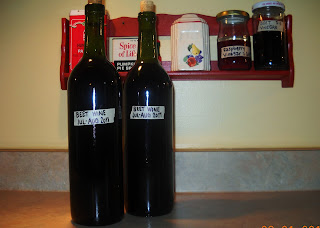The strength of the finished product
is in direct proportion to the amount
of sugar in the original solution.
Preservatives will prevent it from turning to vinegar.
Acquire a "mother."
This is the slimy looking thing floating around
that consists of acetic acid bacteria and cellulose.
It can only be found
in unpasteurized and unfiltered vinegar.
The Bragg's brand
of raw apple cider vinegar
has a mother in it.
You can find it in some grocery markets
and at your local co-op.
Do not use malt vinegar culture.
Choose a glass or enameled earthenware container for storage.
Never use metal.
Oxygen is necessary,
which is why we often see
wide jars used for this purpose.
Fill to the widest point with
your vinegar source.
wine
(2 parts wine to 1 part unchlorinated water)
cider
beer
fermented fruit juice
Cover the opening with layers of
cheesecloth and tie shut.
This allows the oxygen in,
and keeps contaminants out.
Keep in a warm, dark place for a spell.
68 - 96 degrees F
3 weeks - 6 months
We're looking for the "mother" now.
You'll know when it's ready,
it will give off the unmistakable
odor of vinegar.
Once it's ready, strain it into a pretty jar
with a cork.
But be sure to save the mother
for your next batch.
Keep out of direct sunlight.
Do not use for pickling.
(Must be reliably 5% acidity for
this purpose.)
Now I'm off to cover my beet vinegar
and raspberry vinegar
with some cheesecloth...
...these useful garden leftovers
still need to breathe!







No comments:
Post a Comment